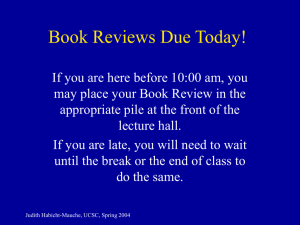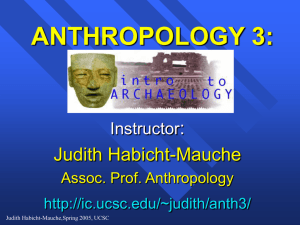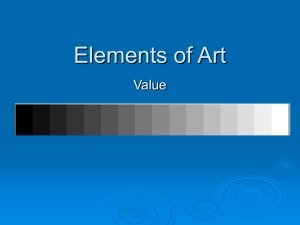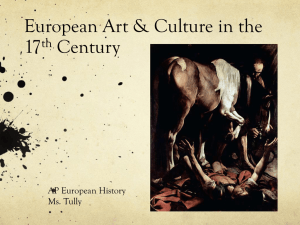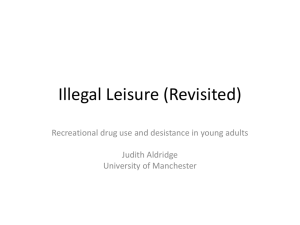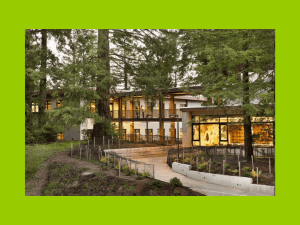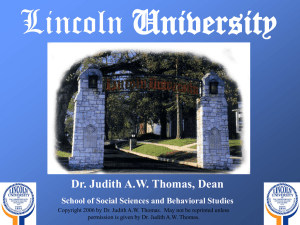Document
advertisement
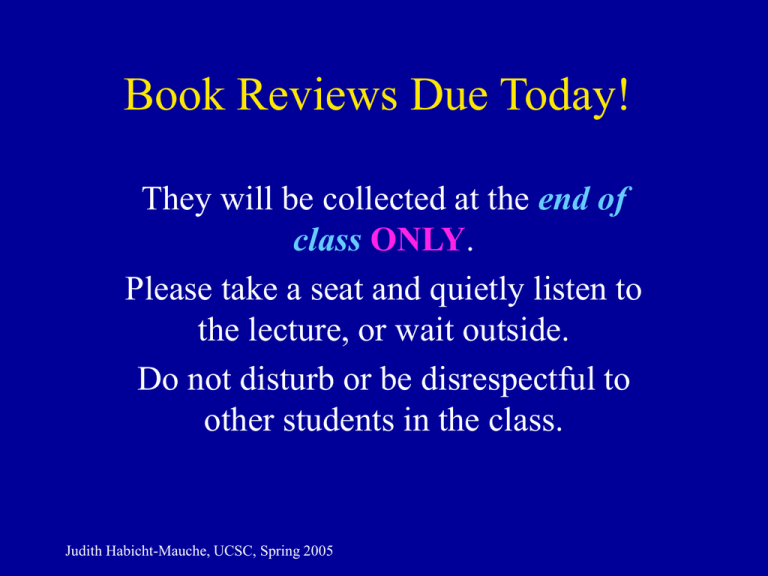
Book Reviews Due Today! They will be collected at the end of class ONLY. Please take a seat and quietly listen to the lecture, or wait outside. Do not disturb or be disrespectful to other students in the class. Judith Habicht-Mauche, UCSC, Spring 2005 Unit 7 Quiz Must be completed by midnight Friday. Judith Habicht-Mauche, UCSC, Spring 2005 Unit 8: Ideology and Worldview Lecture 1 Ideology and Practice: The Archaeology of Habitus Judith Habicht-Mauche, UCSC, Spring 2005 Humans face common problems that require rationalization: Individual Needs: To explain how world works For sense of control in face of crisis To cope with death and fate of human psyche Judith Habicht-Mauche, UCSC, Spring 2005 Societal Needs: To create consensus about right and wrong To validate transitions in personal and communal life To legitimize social institutions Ideology: broad set of rationalizations for common human problems and experiences. Religion: ideology that deals with understanding the relationship between humans and the supernatural. structures of the mind culturally-constructed; shared and learned in social contexts influences how we perceive and act in the material world of our experience Judith Habicht-Mauche, UCSC, Spring 2005 Pierre Bourdieu (1977) A Theory of Practice Habitus: our internalized, embodied view of how the world works and how things should be done. Constituted in practice; in how we go about our daily lives; in how we experience the world. Manifested materially Continually reproduced or transformed Judith Habicht-Mauche, UCSC, Spring 2005 Archaeological Case Study: James Deetz (1977) In Small Things Forgotten Argument: between 1607 and 1760 English colonists experienced major transformation in how they conceived, ordered and lived in the world. This change left distinct imprint on their material surroundings. Judith Habicht-Mauche, UCSC, Spring 2005 Example: Domestic Architecture “People are conceived, are born, and die in houses…The form of a house can be a strong reflection of the needs and the minds of those who built it; in addition, it shapes and directs their behavior.” (Deetz 1977) Judith Habicht-Mauche, UCSC, Spring 2005 The Anglo-American Worldview Medieval Mindset 17th-early 18th c. Group oriented, corporate, organic, vernacular Early 17th. Century “longhouses” from Plymouth Colony in NE Reconstructed “Earthfast” houses at Jamestown, VA Judith Habicht-Mauche, UCSC, Spring 2005 “A Gothic building evolved…It was not planned…it just grew.” (Hugh Morrison) Typical English “Hall and Parlor” Plan Fairbanks House, Dedham, MA. Built 1637. Typical Hall and Parlor Plan, showing organic growth through time Judith Habicht-Mauche, UCSC, Spring 2005 Bacon’s Castle, VA. Built 1665. “Jacobeanstyle” w/ Flemish gables and more vernacular, organic, cross-shaped plan. The Anglo-American Worldview Georgian Order Mid 18th c. Focus on individual, formal, orderly, more academic, popular Judith dug here! Shirley Plantation, VA. Built ca. 1738 Judith Habicht-Mauche, UCSC, Spring 2005 Typical Georgian house plan w/ central hall and more specialized use of space. Georgian architecture is orderly, planned, and based on popular, academic principles of design 3 5 4 3 5 3 Classic 3-4-5 proportions of Shirley Plantation mansion and flanking dependencies. 5 5 4 Judith Habicht-Mauche, UCSC, Spring 2005 4 The Georgian worldview emphasizes form over function Balance and Order Judith Habicht-Mauche, UCSC, Spring 2005 The Georgian worldview places more emphasis on the individual Judith Habicht-Mauche, UCSC, Spring 2005 Transformation of Medieval Wordview to Georgian Worldview Result of economic expansion of mercantile capitalism in Anglo-America Rise of literate, secular, middle class Artificial means to impose balance and order on increasingly uncertain social and material world Judith Habicht-Mauche, UCSC, Spring 2005 Building on Deetz’ Model Mark Leone (1980s) Historic Anapolis, MD Critiqued Deetz for not taking into account issues of POWER AND AGENCY Internal contradictions: Rich/Poor; Free/Slave; British/American Threats to economic and political stability of new American middle class Judith Habicht-Mauche, UCSC, Spring 2005 William Paca’s Garden, Anapolis Ostentatious displays of Power and Wealth Symmetry and Order demonstrate control over nature Georgian style formal garden in VA Reconstructed plan of garden of 18th. century land owner, William Paca, in Annapolis, MD Judith Habicht-Mauche, UCSC, Spring 2005 Ordering Nature = Naturalizing Order Discursive acts designed to stabilize and assert individual prosperity and power--not just a material reflection of it. Mark Leone and his colleagues were concerned to show how Paca’s power “was placed in law and nature…in practicing law and gardening.” Judith Habicht-Mauche, UCSC, Spring 2005 How we will collect the Book Reviews…. The TAs will place signs on the front of the stage w/ the title of each book. Exit your row to the right, walk down the side aisle to the front, forming a single line. Place your paper in the proper pile. Exit up the left-hand aisle. Judith Habicht-Mauche, UCSC, Spring 2005
